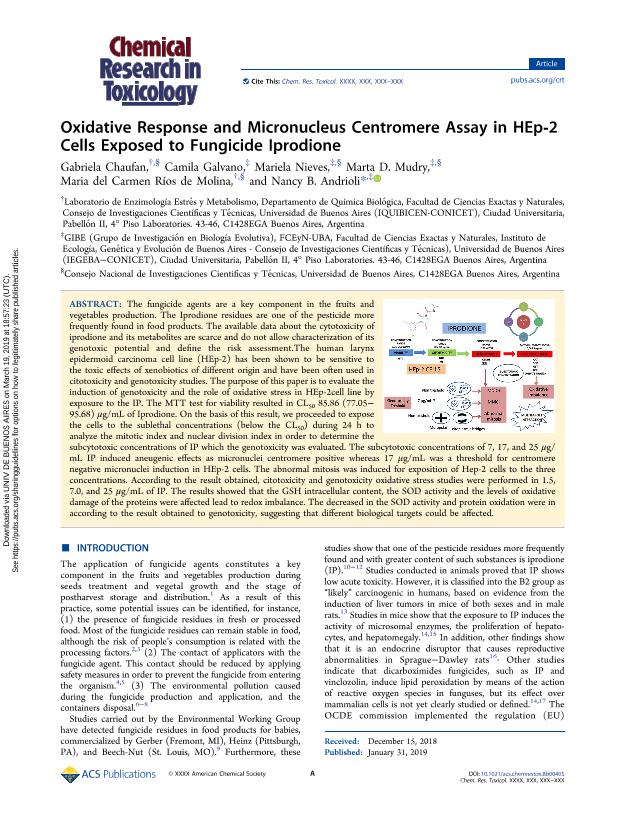Artículo
Oxidative Response and Micronucleus Centromere Assay in HEp-2 Cells Exposed to Fungicide Iprodione
Chaufan, Gabriela ; Galvano, Camila; Nieves, Mariela
; Galvano, Camila; Nieves, Mariela ; Mudry, Marta Dolores
; Mudry, Marta Dolores ; Rios, Maria del Carmen
; Rios, Maria del Carmen ; Andrioli, Nancy Beatriz
; Andrioli, Nancy Beatriz
 ; Galvano, Camila; Nieves, Mariela
; Galvano, Camila; Nieves, Mariela ; Mudry, Marta Dolores
; Mudry, Marta Dolores ; Rios, Maria del Carmen
; Rios, Maria del Carmen ; Andrioli, Nancy Beatriz
; Andrioli, Nancy Beatriz
Fecha de publicación:
04/2019
Editorial:
American Chemical Society
Revista:
Chemical Research In Toxicology (Washington)
ISSN:
0893-228X
Idioma:
Inglés
Tipo de recurso:
Artículo publicado
Clasificación temática:
Resumen
The fungicide agents are a key component in the fruits and vegetables production. The Iprodione residues are one of the pesticide more frequently found in food products. The available data about the cytotoxicity of iprodione and its metabolites are scarce and do not allow characterization of its genotoxic potential and define the risk assessment.The human larynx epidermoid carcinoma cell line (HEp-2) has been shown to be sensitive to the toxic effects of xenobiotics of different origin and have been often used in citotoxicity and genotoxicity studies. The purpose of this paper is to evaluate the induction of genotoxicity and the role of oxidative stress in HEp-2cell line by exposure to the IP. The MTT test for viability resulted in CL 50 85.86 (77.05-95.68) μg/mL of Iprodione. On the basis of this result, we proceeded to expose the cells to the sublethal concentrations (below the CL 50 ) during 24 h to analyze the mitotic index and nuclear division index in order to determine the subcytotoxic concentrations of IP which the genotoxicity was evaluated. The subcytotoxic concentrations of 7, 17, and 25 μg/mL IP induced aneugenic effects as micronuclei centromere positive whereas 17 μg/mL was a threshold for centromere negative micronuclei induction in HEp-2 cells. The abnormal mitosis was induced for exposition of Hep-2 cells to the three concentrations. According to the result obtained, citotoxicity and genotoxicity oxidative stress studies were performed in 1.5, 7.0, and 25 μg/mL of IP. The results showed that the GSH intracellular content, the SOD activity and the levels of oxidative damage of the proteins were affected lead to redox imbalance. The decreased in the SOD activity and protein oxidation were in according to the result obtained to genotoxicity, suggesting that different biological targets could be affected.
Palabras clave:
FUNGICIDE IPRODIONE
,
MICRONUCLEUS
,
OXIDATIVE RESPONSE
,
HEp-2 CELLS
,
MICRONUCLEUS
Archivos asociados
Licencia
Identificadores
Colecciones
Articulos(IEGEBA)
Articulos de INSTITUTO DE ECOLOGIA, GENETICA Y EVOLUCION DE BS. AS
Articulos de INSTITUTO DE ECOLOGIA, GENETICA Y EVOLUCION DE BS. AS
Articulos(IQUIBICEN)
Articulos de INSTITUTO DE QUIMICA BIOLOGICA DE LA FACULTAD DE CS. EXACTAS Y NATURALES
Articulos de INSTITUTO DE QUIMICA BIOLOGICA DE LA FACULTAD DE CS. EXACTAS Y NATURALES
Citación
Chaufan, Gabriela; Galvano, Camila; Nieves, Mariela; Mudry, Marta Dolores; Rios, Maria del Carmen; et al.; Oxidative Response and Micronucleus Centromere Assay in HEp-2 Cells Exposed to Fungicide Iprodione; American Chemical Society; Chemical Research In Toxicology (Washington); 32; 4; 4-2019; 745-752
Compartir
Altmétricas



